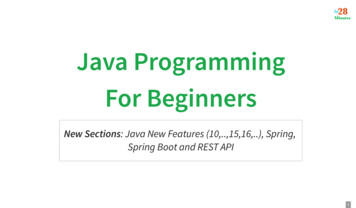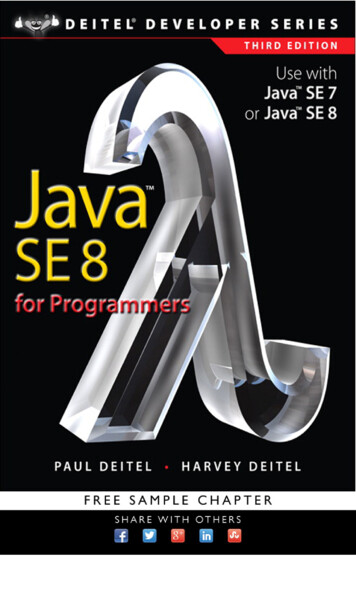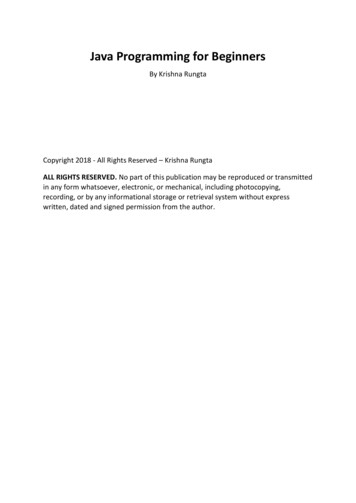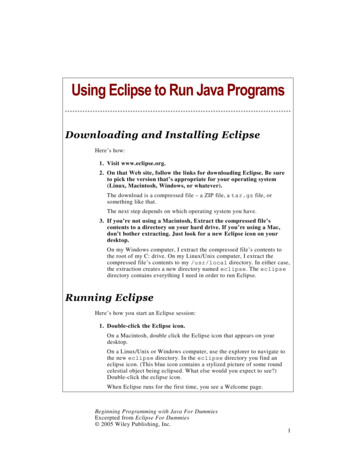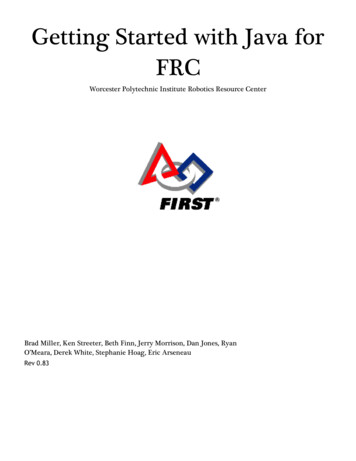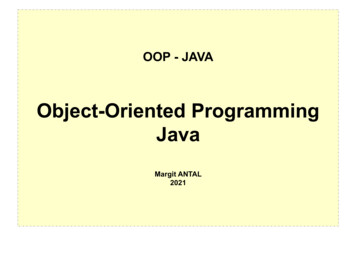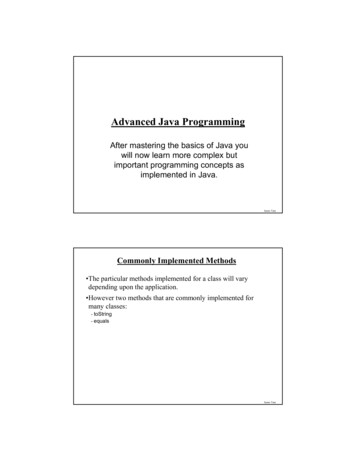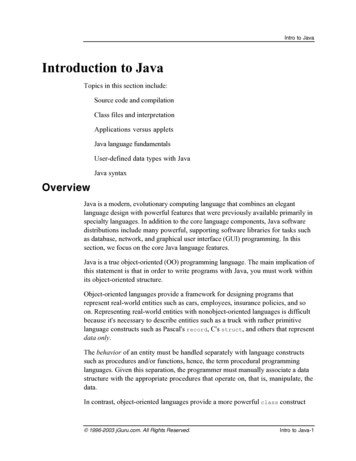
Transcription
Intro to JavaIntroduction to JavaTopics in this section include: Source code and compilation Class files and interpretation Applications versus applets Java language fundamentals User-defined data types with Java Java syntaxOverviewJava is a modern, evolutionary computing language that combines an elegantlanguage design with powerful features that were previously available primarily inspecialty languages. In addition to the core language components, Java softwaredistributions include many powerful, supporting software libraries for tasks suchas database, network, and graphical user interface (GUI) programming. In thissection, we focus on the core Java language features.Java is a true object-oriented (OO) programming language. The main implication ofthis statement is that in order to write programs with Java, you must work withinits object-oriented structure.Object-oriented languages provide a framework for designing programs thatrepresent real-world entities such as cars, employees, insurance policies, and soon. Representing real-world entities with nonobject-oriented languages is difficultbecause it's necessary to describe entities such as a truck with rather primitivelanguage constructs such as Pascal's record, C's struct, and others that representdata only.The behavior of an entity must be handled separately with language constructssuch as procedures and/or functions, hence, the term procedural programminglanguages. Given this separation, the programmer must manually associate a datastructure with the appropriate procedures that operate on, that is, manipulate, thedata.In contrast, object-oriented languages provide a more powerful class construct 1996-2003 jGuru.com. All Rights Reserved.Intro to Java-1
Intro to Javafor representing user-defined entities. The class construct supports the creationof user-defined data types, such as Employee, that represent both the data thatdescribes a particular employee and the manipulation or use of that data.Java programs employ user-defined data types liberally. Designing nontrivial Javaclasses requires, of course, a good working knowledge of Java syntax. Thefollowing sections, illustrate Java syntax and program design in the context ofseveral Java class definitions.User-defined Data TypesWith Java, every computer program must define one or more user-defined datatypes via the class construct. For example, to create a program that behaves likea dog, we can define a class that (minimally) represents a dog:class Dog {void bark() {System.out.println("Woof.");}}This user-defined data type begins with the keyword class, followed by thename for the data type, in this case, Dog, followed by the specification of what itis to be a dog between opening and closing curly brackets. This simple exampleprovides no data fields, only the single behavior of barking, as represented by themethod bark().MethodsA method is the object-oriented equivalent of a procedure in nonobject-orientedlanguages. That is, a method is a program construct that provides the mechanism(method) for performing some act, in this case, barking. Given an instance of someentity, we invoke behavior with a dot syntax that associates an instance with amethod in the class definition:Method Invocation Syntax instance . behavior () variable instance . behavior ( arguments .)To elicit a bark from a dog fido, for example, the operation would be:fido.bark()Intro to Java-2 1996-2003 jGuru.com. All Rights Reserved.
Intro to JavaSyntactically, Java supports passing data to a method and capturing a valuereturned from a method, neither of which takes place in the previous invocation.Java is a strongly typed language, meaning that it expects variables, variablevalues, return types, and so on to match properly, partly because data types areused to distinguish among multiple methods with the same name. Method returntypes and parameters are specified during definition:Method Definition Syntaxvoid method-name ( arguments .) { statements .} return-type method-name ( arguments .) { statements .}Historically, the combination of method name, return type, and argument list iscalled the method signature. With modern OO languages, a class may definemultiple methods with the same name, as long as they are distinguishable by theirsignatures; this practice is called method overloading. Java has the restriction thatreturn type does not contribute to the method signature, thus, having twomethods with the same names and arguments, but different return types is notpossible.For the current example, the return type of void indicates that bark() does notcompute any value for delivery back it to the invoking program component. Also,bark() is invoked without any arguments. In object parlance, invoking a methodrelative to a particular object (a class instance) is often called message passing. Inthis case, the message contains no supplemental data (no arguments).For now, if we create an instance of Dog, it can bark when provoked, but we haveno way of representing data, for example, how many times it will bark, its breed,and so on. Before looking at language constructs that will make the Dog data typemore versatile, we must consider a mechanical aspect of the Java language, namely,what's necessary to run a program.Java ApplicationsWith the Java class and method syntax in hand, we can design a Java program.Java applications consist of one or more classes that define data and behavior.Java applications are translated into a distilled format by a Java compiler. This 1996-2003 jGuru.com. All Rights Reserved.Intro to Java-3
Intro to Javadistilled format is nothing more than a linear sequence of operation-operand(s)tuples: operation operand operation operand operation operand This stream of data is often called a bytecode stream, or simply Java bytecodes.The operations in the bytecode stream implement an instruction set for a so-calledvirtual machine (software-based instruction processor), commonly called a Javavirtual machine (JVM). Programs that implement the JVM simply process Javaclass files, sometimes specific to a particular environment. For example, Javaenabled web browsers such as Netscape Navigator and Internet Explorer include aJVM implementation. Standalone programs that implement the JVM are typicallycalled Java interpreters.The Java compiler stores this bytecode stream in a so-called class file with thefilename extension .class. Any Java interpreter can read/process this stream--it"interprets" each operation and its accompanying data (operands). Thisinterpretation phase consists of (1) further translating the distilled Java bytecodesinto the machine instructions for the host computer and (2) managing theprogram's execution. The following diagram illustrates the compilation andexecution processes:Java class files are portable across platforms. Java compilers and interpreters aretypically not portable; they are written in a language such as C and compiled toIntro to Java-4 1996-2003 jGuru.com. All Rights Reserved.
Intro to Javathe native machine language for each computer platform. Because Java compilersproduce bytecode files that follow a prescribed format and are machineindependent, and because any Java interpreter can read and further translate thebytecodes to machine instructions, a Java program will run anywhere--withoutrecompilation.A class definition such as Dog is typically stored in a Java source file with amatching name, in this case, Dog.java. A Java compiler processes the source fileproducing the bytecode class file, in this case, Dog.class. In the case of Dog,however, this file is not a Java program.A Java program consists of one or more class files, one of which must define aprogram starting point--Dog.class does not. In other words, this starting point isthe difference between a class such as Dog and a class definition that implements aprogram. In Java, a program's starting point is defined by a method namedmain(). Likewise, a program must have a well-defined stopping point. In Java,one way to stop a program is by invoking/executing the (system) method exit().So, before we can do anything exciting, we must have a program that starts andstops cleanly. We can accomplish this with an arbitrary, user-defined data typethat provides the main() and exit() behavior, plus a simple output operation toverify that it actually works:public class SimpleProgram {public static void main(String[] args) {System.out.println("This is a simple program.");System.exit(0);}}The signature for main() is invariable; for now, simply define a program entrypoint following this example--with the modifiers public and static and thereturn type void. Also, System (java.lang.System) is a standard class suppliedwith every Java environment; it defines many utility-type operations. Twoexamples are illustrated here: (1) displaying data to the standard output device(usually either an IDE window or an operating system command window) and (2)initiating a program exit.Note that the 0 in the call to exit() indicates to the calling program, the Javainterpreter, that zero/nothing went wrong; that is, the program is terminatingnormally, not in an error state.At this point, we have two class definitions: one, a real-world, user-defined datatype Dog, and the other, a rather magical class that connects application-specific 1996-2003 jGuru.com. All Rights Reserved.Intro to Java-5
Intro to Javabehavior with the mechanics of starting and stopping a program.Now is a good time to get acquainted with your Java development environment. Ifyou have an integrated development environment (IDE), it may or may not be fileoriented. With most environments Java source code is stored in a file. One popularexception is IBM's VisualAge for Java, which stores class definitions in aworkspace area.When using an IDE that is file-oriented, note that the filenames and class namesmust match exactly; in particular, the file and class names are case sensitive. Also,you must work within the rules established for a Java environment with respect tosystem environment variable settings, and so on. The section RuntimeEnvironments and Class Path Settings includes general information on systemsettings.The first magercise is simple but important, because it tests your Javaconfiguration. It includes these basic steps: Write SimpleProgram exactly as shown here Save it as required by the IDE Somewhere in the IDE workspace environment Or, in a separate file named SimpleProgram.java depending on the IDE Build the program Execute it Observe the outputMagercises occur throughout the course; simply follow the links.Applications versus AppletsA Java application consists of one or more class files, one of which defines themain() method. You can run an application in any environment that provides aJava interpreter, for example, anywhere there's a Java IDE. The Java RuntimeEnvironment (JRE) from Sun provides an interpreter as well, but omits thedevelopment-related tools such as the compiler.A Java applet is not an application; it does not define main(). Instead, appletsdepend on host applications for start-up, windowing, and shut-down operations,Intro to Java-6 1996-2003 jGuru.com. All Rights Reserved.
Intro to Javatypically, a web browser:Many applets simply render a graphical image in a designated area of the webbrowser window; others provide a GUI with command buttons that initiateapplication-specific operations. Applets operate under several securityrestrictions, which protects users from unknowingly downloading applets thatsnoop for private data, damage local file systems, and so on.Applet programming involves many Java concepts that are, by definition, beyondthe scope of an introductory section. The final topic in this section includes anintroduction to applets (Java Applets).Java Commenting SyntaxJava supports three types of commenting, illustrated in the following table:Comment ExampleDescriptionint x; // a commentRemainder of line beginning with "//" is a commentarea/*The variable x is aninteger:*/int x;All text between the "/*" and "*/", inclusive, isignored by compiler/**x -- an integerrepresenting the xcoordinate*/int x;All text between the "/**" and "*/", inclusive, isignored by compiler and intended for javadocdocumentation utility 1996-2003 jGuru.com. All Rights Reserved.Intro to Java-7
Intro to Javacoordinate*/int x;documentation utilityThe javadoc documentation tool is quite powerful. The standard Javadistribution from Sun includes documentation built with javadoc; hence, oneavenue for learning this tool is to study the HTML documentation alongside theJava source code, which contains the comments that javadoc converts intoHTML.Variable Definition and AssignmentGiven a user-defined data type such as Dog, we would like to create an instance ofDog and use it subsequently in a program. Doing so requires both variabledefinition and assignment operations. A data definition operation specifies a datatype and a variable name, and optionally, an initial value:Data Definition data-type variable ; data-type variable-1 , variable-2 , ., variable-n ; data-type variable data-value ;The data type may be a primitive, or built-in, type or a user-defined type such asDog. The value may be a literal value or an instance of a user-defined type such asDog. Primitive data types are discussed in Java Data Types.Several examples of data definitions follow:Data Definition Examplesint x;int x 9;boolean terminate false;Dog dog new Dog();The new operator is described in the next section (Creating Class Instances).An assignment operation can occur in the following contexts:Intro to Java-8 1996-2003 jGuru.com. All Rights Reserved.
Intro to JavaAssignment Operation data-type variable data-value ; data-type variable ; other-statements . variable data-value ;The data value to the right of the assignment operator can be a literal value, or anyoperation that produces a scalar value. Several examples follow:Assignment ExampleCommentint x 4;Data definition with assignmentx 9;Assumes prior definition of xtemperature 21.4;Assumes prior definition of temperaturedog new Dog();Assumes prior definition of dogCreating Class InstancesWith the capability for starting and stopping a program, plus variable definitionand assignment, we can now use the previously developed data type Dog. First,we modify SimpleProgram to have a more meaningful name, for example,ADogsLife:public class ADogsLife {public static void main(String[] args) {System.exit(0);}}Next, we define the program's behavior in terms of its main() method.Specifically, main() creates an instance of Dog named dog (case is significant inJava) and provokes the dog to bark:public class ADogsLife {public static void main(String[] args) {Dog dog new Dog();dog.bark();System.exit(0);}} 1996-2003 jGuru.com. All Rights Reserved.Intro to Java-9
Intro to JavaIn Java, as with other languages, a program allocates objects dynamically. Java'sstorage allocation operator is new:Storage Allocation Syntaxnew data-type ( arguments .) data-type variable new data-type ( arguments .)The new operator asks the Java runtime environment to create dynamically (on thefly) an instance of a user-defined data type, for example, "new Dog()". You canalso associate the instance with a variable for future reference (hence, the termreference variable), for example, "Dog bowwow new Dog()". The data type forthe reference variable bowwow must be specified to the left of the variable name, inthis case, "Dog bowwow".Objects receive their storage on/from the heap, which is simply a memory poolarea managed by the Java interpreter. The following diagram illustrates thememory allocation for the class files, plus the instance of Dog allocated on theheap:Java Data TypesJava supports a variety of primitive (built-in) data types such as int forrepresenting integer data, float for representing floating-point values, and others,as well as class-defined data types that exist in supporting libraries (Javapackages). (All Java primitive data types have lowercase letters.)The String class is defined in java.lang, the core package of supplemental classdefinitions that are fundamental to Java programming. A more complete referenceto this class includes the package specification java.lang.String. (ByIntro to Java-10 1996-2003 jGuru.com. All Rights Reserved.
Intro to Javaconvention, class names have mixed-case letters: the first letter of each word isuppercase.)The Java language has the following primitive types:Primitive Type Descriptionbooleantrue/falsebyte8 bitschar16 bits (UNICODE)short16 bitsint32 bitslong64 bitsfloat32 bits IEEE 754-1985double64 bits IEEE 754-1985For an overview of common nonprimitive data types, that is, class definitionsprovided by the Java environment, see the java.lang package within thestandard Java distribution documentation, or the documentation supplied withyour Java IDE.Method OverloadingNot all dogs sound alike, however, so to add a little barking variety to the Dogimplementation, we should define an alternative bark() method that accepts abarking sound as a string:class Dog {void bark() {System.out.println("Woof.");}}void bark(String barkSound) {System.out.println(barkSound);}This version of Dog is legal because even though we have two bark() methods, 1996-2003 jGuru.com. All Rights Reserved.Intro to Java-11
Intro to Javathe differing signatures allows the Java interpreter to chose the appropriatemethod invocation. The method definition syntax "void bark(StringbarkSound)" indicates that this variation of bark() accepts an argument of typeString, referred to within the method as barkSound.As another example of method overloading, consider the program DogChorus,which creates two dogs and elicits a different barking behavior for each dog:public class DogChorus {public static void main(String[] args) {Dog fido new Dog();Dog spot new Dog();fido.bark();spot.bark("Arf. Arf.");fido.bark("Arf. Arf.");System.exit(0);}}Because Dog supports two different barking behaviors, both defined by methodsnamed bark(), we can design our program to associate either barking behaviorwith, say, fido. In DogChorus, we invoke different barking behaviors for fidoand spot. Note that fido changes his bark after hearing spot.Instance VariablesSo far, we're defining instances of objects in terms of their behaviors, which inmany cases is legitimate, but, in general, user-defined data types incorporate statevariables as well. That is, for each instance of Dog, it's important to supportvariability with respect to characteristics such as hair color, weight, and so on.State variables that distinguish one instance of Dog from another are called instancevariables.Now suppose we add an instance variable to reflect a particular dog's barkingsound; a String instance can represent each dog's bark:class Dog {String barkSound new String("Woof.");void bark() {System.out.println(barkSound);}}void bark(String barkSound) {System.out.println(barkSound);}Intro to Java-12 1996-2003 jGuru.com. All Rights Reserved.
Intro to JavaThe definition of Dog now includes the instance variable barkSound. Each time anew instance of Dog is created, that instance will include a reference variable for aninstance of String representing that particular dog's bark. This instance variable isinitialized to the default value of "Woof.". Consider the line of codeString barkSound new String("Woof.");This statement allocates an instance of String, initializes it with the value"Woof." (provided in the parentheses following the String class name), andstores this data under the reference variable barkSound. Note that the referencevariable barkSound is part of each instance of Dog, but that it references aninstance of String that's allocated on the heap, as is the instance of Dog:Now that the default barking behavior is represented by an instance variable, wecan remove the "Woof." data from the original bark() method, replacing it with areference to the current value of barkSound:void bark() {System.out.println(barkSound);}That is, we've transferred unconditional state data from a method definition intoan instance variable that can vary from one dog to the next, and perhaps moreimportantly, for a particular dog, its value can change dynamically.Access MethodsIn order for the value of an instance variable to vary over time, we must supply amethod to change its value; such a method is typically referred to as an accessmethod. By convention, a method that's provided simply to affect a change to aninstance variable's value begins with the word "set": 1996-2003 jGuru.com. All Rights Reserved.Intro to Java-13
Intro to Javavoid setBark(String barkSound) {this.barkSound barkSound;}This method is interesting because it uses two different variables with the samename, barkSound. First, the barkSound defined as an parameter is the newbarking sound. Any unqualified reference to barkSound within this method refersto this data passed as an argument. We also have, however, a barkSound instancevariable for each dog that is instantiated. With Java, we can use the special"instance handle" this to refer to the current instance of Dog. Hence,this.barkSound barkSound;replaces the current value of the instance variable (this.barkSound with the newvalue passed as an argument (barkSound) to setBark().To put the this variable in perspective, suppose we create an instance of Dogreferred to as fido. Then, if we execute setBark() with respect to fido, namely,fido.setBark("Ruff.");the this instance in setBark()is fido and, in particular, this.barkSound is thebarkSound instance variable for the fido object.In the following version of DogChorus, we create an object, fido, change itsbarking characteristic from the default "Woof." to "Ruff.", and then invoke thebarking behavior:public class DogChorus {public static void main(String[] args) {Dog fido new t(0);}}With this modification, the characteristics of an object such as fido are reflectedby both the current values of instance/state variables and the available behaviorsdefined by the methods in Dog.Instance MethodsThe type of methods we're designing at present are called instance methodsbecause they are invoked relative to a particular instance of a class. For thisreason, an instance method can reference an instance variable directly, without thethis qualifier, as long as there is no variable name conflict, for example,Intro to Java-14 1996-2003 jGuru.com. All Rights Reserved.
Intro to Javavoid bark() {System.out.println(barkSound);}In this case, the no-argument version of bark() references the instance variablebarkSound directly. As implied by the setBark() definition, however, we couldalso write bark() as follows:void bark() {System.out.println(this.barkSound);}Here, there are no other variables within (local to) bark() named barkSound, sothese implementations are equivalent.Conditional ExecutionSo far, within each method we've used sequential execution only, executing onestatement after another. Like other languages, Java provides language constructsfor conditional execution, specifically, if, switch, and the conditional operator ?.Conditional Constructsif ( boolean-expression ) statement .else statement .switch ( expression ) {case const-expression : statements .break;more-case-statement-break-groups.}default: statements .( boolean-expression ) ? if-true-expression : if-false-expression The more general construct, if has the syntax:if ( boolean-expression ) statement .where statement . can be one statement, for example, 1996-2003 jGuru.com. All Rights Reserved.Intro to Java-15
Intro to Javax 4;or multiple statements grouped within curly brackets (a statement group), forexample,{}x 4;y 6;and boolean-expression is any expression that evaluates to a boolean value,for example,BooleanExpressionInterpretationx 3xx yx is equal to yx yx is greater than or equal to yx ! 10x variable variable is trueis less than 3is not equal to 10If the Boolean expression evaluates to true, the statement (or statement group)following the if clause is executed.Java also supports an optional else clause; the syntax is:if ( boolean-expression ) statements .else statements .If the Boolean expression evaluates to true, the statement (or statement group)following the if clause is executed; otherwise, the statement (or statement group)following the else clause is executed.Boolean expressions often include one or more Java comparison operators, whichare listed in the following table:ComparisonOperatorIntro to Java-16Interpretation 1996-2003 jGuru.com. All Rights Reserved.
Intro to JavaOperator less than less than or equal to greater than greater than or equal to equal to! not equal toReturning to our user-defined type Dog, we can add additional state variables formore flexible representation of real-world objects. Suppose we add instancevariables gentle and obedienceTrained, which can be true or false:class Dog {String barkSound new String("Woof.");boolean gentle true;boolean obedienceTrained false;.In Java, Boolean values are literals (case is significant), and boolean variablesaccept either value. For gentle and obedienceTrained there are no newoperators because we're not creating objects--we're creating primitive variables andassigning them the default values true and false.Access methods provide the flexibility for modifying these instance variables on adog-by-dog basis:void setGentle(boolean gentle) {this.gentle gentle;}void setObedienceTrained(boolean trained) {obedienceTrained trained;}Note that the reference to obedienceTrained in setObedienceTrained() doesnot require qualification with this because there is no local variable by the samename. 1996-2003 jGuru.com. All Rights Reserved.Intro to Java-17
Intro to JavaMethods that Return ValuesWith these new variables, we can provide convenience methods such asboolean isGoodWithChildren() {if (gentle true && obedienceTrained true)return true;elsereturn false;}This method introduces additional Java syntax. First, instead of the modifier void,isGoodWithChildren() provides a return type, in this case, boolean. With thereplacement of void by either a primitive, system-, or user-defined data type, themethod must provide a return statement for every execution path possiblethrough the method--the Java compiler enforces this "contract."A return statement has the syntaxreturn value ;where value is any expression that evaluates to the appropriate return datatype.For isGoodWithChildren(), if the if statement's Boolean expression evaluatesto true, the first return executes, which terminates the method execution andreturns the result of the evaluation, which in this case is simply the literal valuetrue. If the Boolean expression evaluates to false, the code block following theelse clause is evaluated, in this case, a single return statement that returns false.In this example, the Boolean expression is compound--it includes two expressions,each with the comparison operator. The comparative expressions are linkedwith the logical and operator &&; hence, the complete expression evaluates totrue only if both subexpressions evaluate to true.Boolean expressions often include one or more Java logical operators, which arelisted in the following table:Logical OperatorInterpretation&&and ("short-circuit" version)&and ("full-evaluation" version)Intro to Java-18 1996-2003 jGuru.com. All Rights Reserved.
Intro to Java or ("short-circuit" version) or ("full-evaluation" version)With the "short-circuit" versions, evaluation of subsequent subexpressions isabandoned as soon as a subexpression evaluates to false (in the case of &&) ortrue (in the case of ).Although isGoodWithChildren() provides a full illustration of if, including theoptional else clause, this method can be coded more succinctly. Java, like C, is asyntactically powerful language. First, we can actually remove the if because thereturn values correspond to the Boolean expression, that is, if the Booleanexpression evaluates to true, return true; otherwise, return false. The moreconcise implementation is:boolean isGoodWithChildren() {return (gentle true && obedienceTrained true);}One more reduction is possible. Note that each subexpression involves a booleanvariable compared to the boolean literal true. In this case, each subexpressioncan be reduced to the boolean variable itself:boolean isGoodWithChildren() {return (gentle && obedienceTrained);}Access Methods RevisitedDog provides set-style access methods for modifying an instance variable. Attimes, it's necessary to retrieve an instance variable's value. Typically, if a classhas instance variables that support set operations, they support get operations aswell. For each of our set methods, we should code a corresponding get method, forexample,boolean getObedienceTrained() {return obedienceTrained;}Note that in the case of boolean instance variables such as obedienceTrained,some programmers prefer the is-style naming convention over the get-style andsome programmers like to provide both:boolean isObedienceTrained() {return obedienceTrained; 1996-2003 jGuru.com. All Rights Reserved.Intro to Java-19
Intro to Java}Note that isGoodWithChildren() from the previous section is not really anaccess method--it does not return (report) an instance variable's value. Instead, itcombines higher level, meaningful information with respect to an instance of theclass Dog.Iterative ExecutionJava provides the while, do-while, and for language constructs for iterating overa statement (or statement group) multiple times. while is the more generaliterative construct; for is the more syntactically powerful.Iterative Constructswhile ( boolean-expression ) statements .do statements .while ( bool
specialty languages. In addition to the core language components, Java software distributions include many powerful, supporting software libraries for tasks such as database, network, and graphical user interface (GUI) programming. In this section, we focus on the core Java language features. Jav



